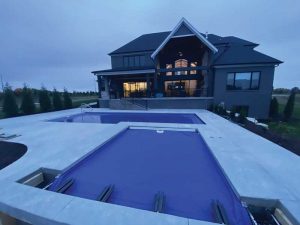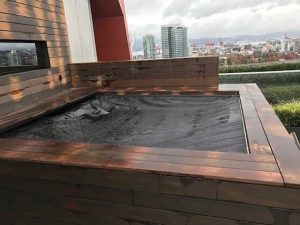
Opportunity for builders
By selling auto covers, many builders are finding they have an opportunity to sell another high-end product in the backyard both for the pool and the spa.
“We are pool builders and all of our pools have auto covers—whether it’s a gunite, vinyl liner, or fibreglass pool,” says Harms. “More times than not, when we follow up on a pool lead the customer says they are also thinking about installing a spa.
“This is when we tell the homeowner we can also build them a spa that will integrate with the pool; we also suggest an auto cover be installed on both the pool and the spa.”
Savvy builders are realizing they have a real opportunity to up-sell a spa alongside the pool, providing the perfect opportunity to sell auto covers on both bodies of water.
“We use this opportunity every time we’re in a client’s backyard,” says Horwood. “Out of habit, pool builders don’t think to offer an auto cover for the spa, but they should because they are missing out on the chance increase their profits—especially when you have a high-end customer that is automating their pool, adding an auto cover on the spa is a natural.”
In fact, many pools will also have a spa without a proper cover which could be a potential drowning hazard.
“Automatic covers are considered safety covers so putting one on a spa can deter unwanted entry into the water,” says Harms. “Pool professionals will not only be offering their client’s convenience, but also help them maintain a safe backyard.”

Planning for auto covers on spas
The biggest difference between installing auto covers on a spa versus a pool is space. When planning for an auto cover on a new spa installation, the challenges are mostly esthetics.
“On a spa, we have more design flexibility than on a pool because it can operate with a smaller motor mechanism,” says Harms. “Most customers like the spa to look as though it has a ‘picture frame’ around the perimeter. We can do this easily because the cavity for the cover box doesn’t need to be as big. This allows us to integrate the auto cover in a manner that is visually appealing.”
Auto covers can be placed on spas that are flush with the deck or sit above the deck: “If the spa is set at grade, or at deck level, then the auto cover box will need to be placed below grade,” says Horwood. “The coping that sits over the box will sit flush with the rest of the deck.”
If the spa sits up above the ground, typically they are raised about 457 to 508 mm (18 to 20 in.) above the deck and, so too, the cover box must sit above the deck.
“To make the auto cover mechanism a part of the spa design on new installations, most builders will usually incorporate the auto-cover box into the spa wall to integrate it with the overall footprint of the spa,” says Horwood.
Depending on the size of the spa, the additional space needed for the mechanism box may only add about 0.35 m (1 ft) to the length of the spa. When Harms is building a gunite spa, he says the walls he constructs are typically 305 mm (12 in.) thick.
“For example, if the water dimension of the spa, from side to side, is 2.4 m (8 ft), then our build dimension, or overall footprint, is 3 m (10 ft) around the perimeter of the spa or 0.35 m on all sides,” says Harms.
“When planning, we make sure the motor unit fits within the 3 m area giving us the room we need for the motor unit as well as the electrical box supplying the power to the unit; it can get tight, so we plan and design in a manner that allows us to shift the system one way or another to increase our available space.”
The situation is often different when builders are looking to install an auto cover on an existing spa installation. Although there is less fabric that needs to roll up in the housing, there tends to be less available space around a spa compared to a pool.
“Oftentimes, the reason someone has decided to install a spa is because they have limited space in their backyard so they may have had to really squeeze it in. This makes it hard to find the necessary space to place the housing for the cover mechanism,” says Horwood.






